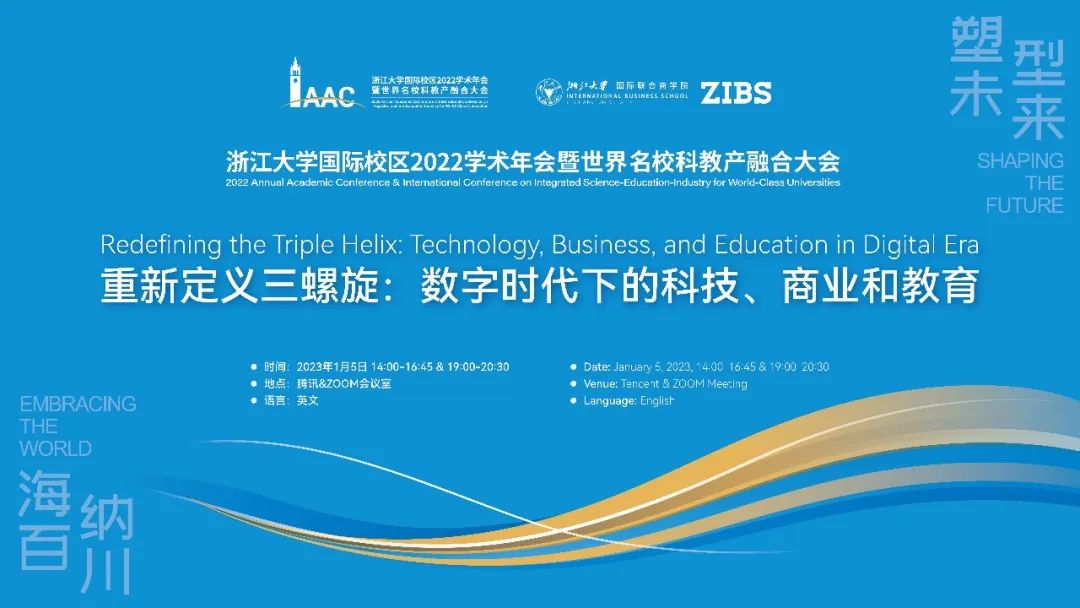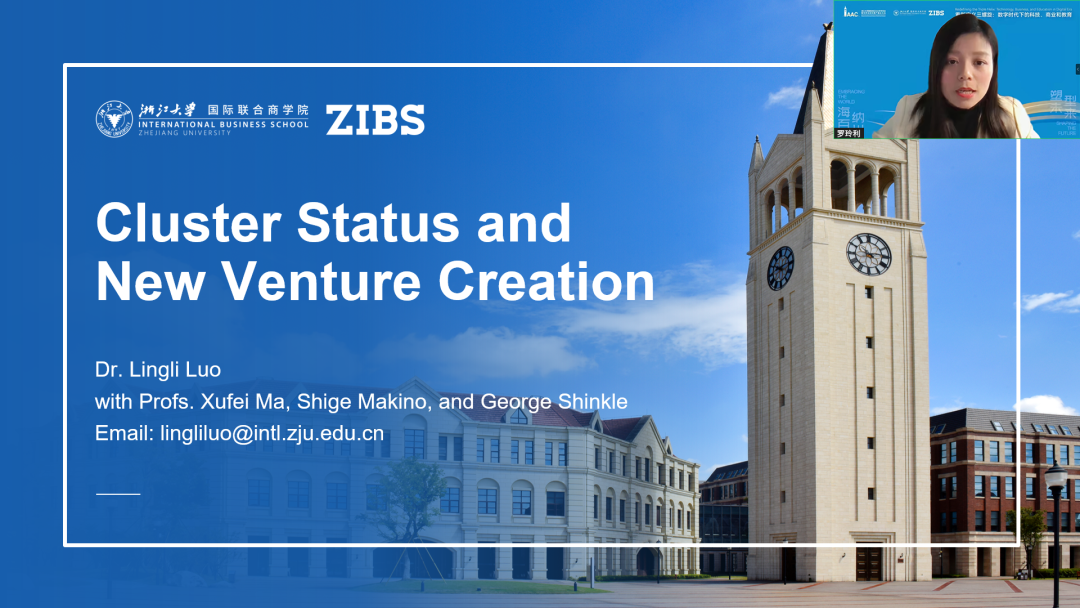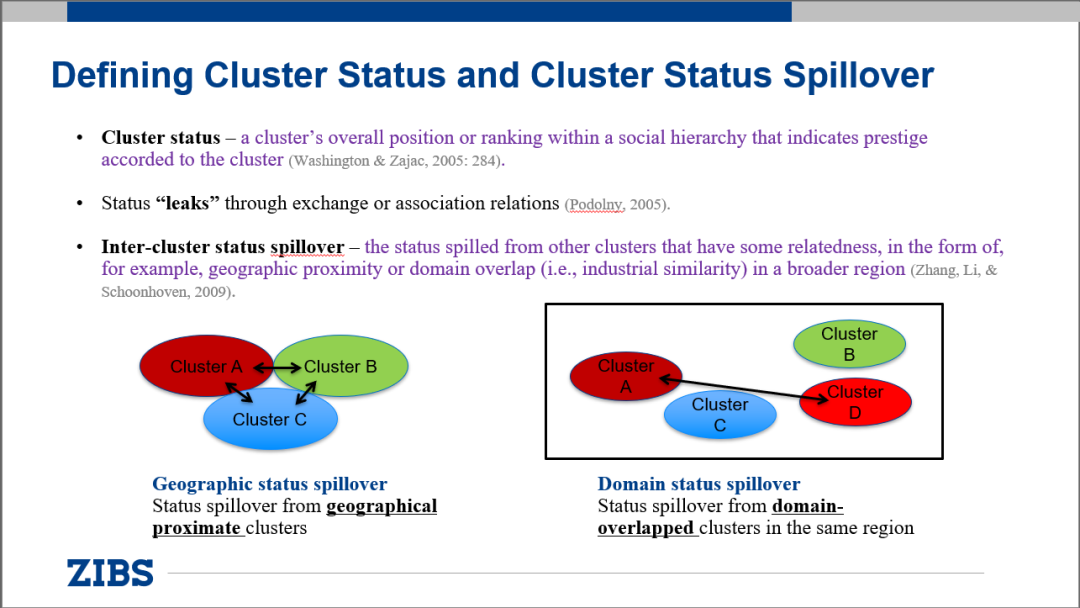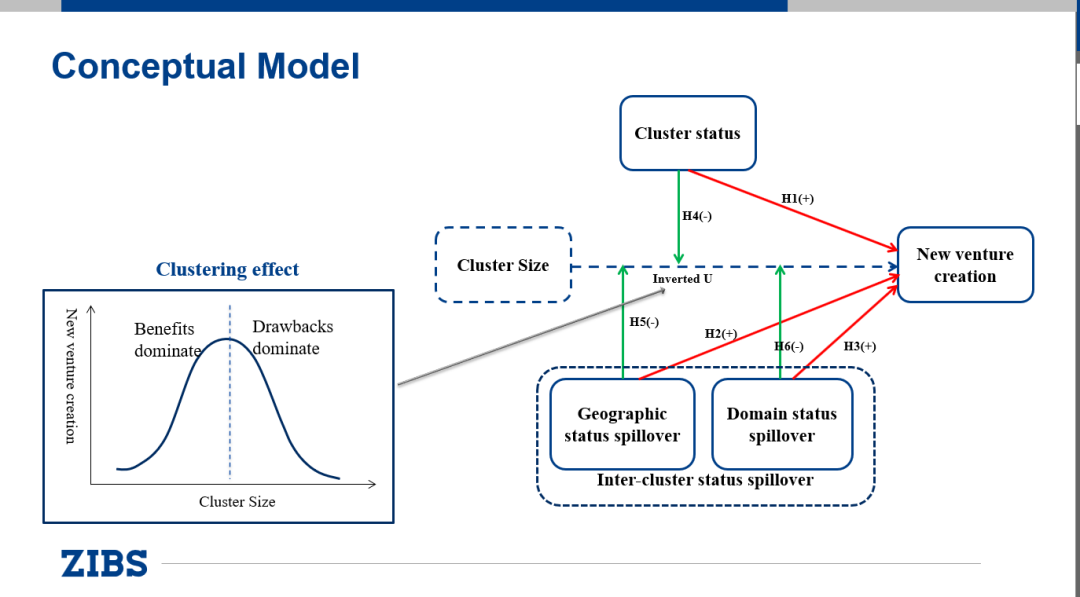//
2022 ZIBS Forum, on the theme of "Redefining the Triple Helix: Technology, Business, and Education in Digital Era", was successfully held on 5 Jan 2023. Scholars and subject-matter specialists presented their recent research findings on digital technology, innovation management, corporate strategy and sustainable development besides other fields of business studies.

The second part of the forum revolved around the integration of academia and industry in the new business era. In this session, ZIBS Assistant Professor LUO Lingli presented her research work — "Cluster Status and New Venture Creation", which was completed in collaboration with Profs. MA Xufei, Shige Makino, and George Shinkle. Here's the review:

This research investigates the factors that influence entrepreneurs' decisions to create new ventures in clusters. Prior studies have provided three predominant explanations:
One is externalities, which capture economic benefits when a larger number of similar firms locate together. Firms in these places can get access to specialized suppliers, skilled labor, increased customers, or even knowledge spillover between co-located firms.
Another explanation is legitimacy. It argues that firms locate in a certain cluster because they want to conform to social norms and expectations by imitating the large number of firms located in the cluster.
In addition, creating a new venture in cluster areas also has drawbacks like intense competition. In clusters, similar firms usually compete for resources and customers more intensely. Firms in clustering areas are more likely to fail than those in non-clustering areas.

Among these explanations, externalities and competition describe the dynamics within clusters, while legitimacy focuses on the external social system of the cluster. There is limited attention to the interdependence between clusters. Moreover, all three explanations view clusters as existing independently. In reality, a cluster's value may depend on other clusters, especially when multiple clusters are embedded in a social system or in a social hierarchy. In this situation, the relative position of the cluster matters! This relative position captures cluster interdependence.
In this study, we use social status theory and introduce two new related concepts — cluster status and inter-cluster status spillover — to investigate how cluster-level status directly influences new venture creation in clusters as an additional explanation.
As mentioned above, three predominant explanations in the literature focus on the benefits and drawbacks of clustering. Some studies have considered both benefits and drawbacks and proposed that cluster size (the number of firms) has an inverted U-shaped relationship with new venture creation. Although this inverted U-shaped clustering effect is well established, it implicitly assumes that the clustering effect is constant for all clusters and we know little about the contingencies of that clustering effect. Therefore, our second research question is to look at how cluster-level status, which acts as a contingency of the clustering effect, indirectly influences new venture creation.

To extend the clustering literature, we draw from social status theory. Prior studies have focused on individual-level and organizational-level status. We extend prior literature to look at cluster-level status. We define cluster status as the overall position or ranking within a social hierarchy that indicates prestige accorded to the cluster. One important nature of social status is that it can flow from one to another through exchange or association relations. Following this logic, we define inter-cluster status spillover as the status spilled from one cluster to another when two clusters are related. We consider two types of dyadic inter-cluster relatedness: geographic proximity and domain overlap.
Given this background, we propose a conceptual framework with two sets of hypotheses.
The first set of hypotheses proposes the direct effect of cluster-level status. We hypothesize that cluster status and status spillover positively affect new venture creation in clusters.
The second set of hypotheses proposes its indirect effect. We hypothesize that cluster status and cluster status spillover have negative moderating (weakening) effects on the existing inverted U-shaped relationship between cluster size and new venture creation.

To test the hypotheses, we collected a sample of township industrial clusters (also called specialized towns or single-product towns) in Guangdong Province, China, from 2005–2013. With a clear leading industry, a large group of firms concentrate In these towns. Most importantly, there is a supportive township government that provides necessary infrastructure elements and favorable policies to foster cluster development. Our data were collected from several public sources including Association for the Promotion of Towns of Industry Clusters of Guangdong Province (POTIC), Annual Industrial Survey Database, Guangdong Statistical Yearbook, and city yearbooks, etc.
Based on empirical analyses of this data, we find that cluster size has an inverted U-shaped relationship with new venture creation, which is consistent with the literature.
We also find that cluster status variables (including cluster status, geographic status spillover, and domain status spillover) have positive effects on new venture creation in clusters.
In addition, we found cluster status and geographic status spillover have negative moderating effects on the clustering effect, namely that they weaken the inverted U-shaped relationship between cluster size and new venture creation.
This research has a few theoretical implications.
1
We theorize and demonstrate the impact of cluster-level status as an additional explanation of clustering;
2
We identify cluster-level status as a boundary condition of the clustering effect as theorized in the existing literature;
3
We extend the social status literature by introducing status at the cluster level;
4
We bring China's township industry clusters into the conversation on clusters, which are rarely studied, especially in international research.
We also suggest a few research avenues for future study. One such opportunity is the digital transformation of industry clusters. Today's industrial clusters, including TICs used in this study, are increasingly and must engage in digital transformation to adapt to the digital era. There are several successful examples. For example, the leather cluster in Guangdong Shiling took a digital-based platform and developed a Cloud ERP system to achieve coordination among supply chain partners, sharing for material processing, finding and selling materials, and hiring workers. In the end, the cluster improved quality, reduced costs, increased efficiency, and reduced inventory. Although there are some successful examples of the digital transformation of industrial clusters in China, research in this area is very limited. We encourage more research on this topic.
More reviews of the forum are coming soon, please stay tuned!
*This article is based on the speech made by ZIBS Assistant Professor LUO Lingli at 2022 ZIBS Forum. The views and opinions expressed in this article are those of the speaker and do not necessarily reflect the views or positions of ZIBS.
The related research article has been officially published in "Journal of Business Venturing", Tap the "Read more" below to learn more.
LUO Lingli
Assistant Professor

Dr. LUO Lingli is an Assistant Professor of Strategic Management at ZIBS. She has received her Ph.D. from the University of New South Wales. Within the area of strategic management, her research interests are focused on behavioral strategy, organizational aspirations, status and reputation. She has published in the Journal of Business Venturing, Journal of Business Ethics, and Asia Pacific Journal of Management, among others. She also serves as an editorial board member of the Asia Pacific Journal of Management.
